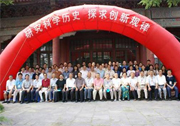| 中文题目: | 从嘉禾到杂草:东北地区的稗子种植与低湿地开发 | ||||||
| 英文题目: | From Grains to Weeds: Barnyard Millet Planting and Low Wetland Development in Northeast China | ||||||
| 作 者: | 杜新豪 | ||||||
| 刊物名称: | 历史地理研究 | ||||||
| 发表年度: | 2023-05-20 | ||||||
| 卷: | 43 | ||||||
| 期: | 02 | ||||||
| 页码: | 94-102+160 | ||||||
| 中文摘要: | 稗在中国主流农业历史叙事中多为稻田伴生杂草或灾荒年份的救荒作物,但在传统时期的东北地区却是一种主粮作物,地位不次于“五谷”,耐寒、耐湿的抗逆性特征使其成为东北地区历史上低湿地开发的主力。当地农民在长期栽培实践中,培育出一批高产、抗涝性状好的品种,形成了一整套颇具特色的种植技术。近代以来,随着东北地区农田水利兴起、抗寒性水稻品种次第引入,先前植稗的沮洳之地被整治为水田,优质高产的水稻成为低湿地开发的主角。稗子作为一种谷物逐渐淡出人们的视野,沦为一种饲料作物。某种程度上说,稗子退却的历史,即近代以来东北亚中高纬度地区低地开发与农业发展的缩影。 |
||||||
| 英文摘要: | Despite that barnyard millet was, in Chinese mainstream narratives on agricultural history, considered a kind of weed that grew along with rice in paddy fields or a rescue crop in years of famine, it was a key staple crop in northeastern China in traditional periods, whose status was not inferior to that of five cereals, The stress resistance attributes, i.e., cold resistant and moisture resistant, made barnyard millet a major player in the development history of low wetlands in northeastern China. Based on their long-term cultivation practices, local famers bred a number of high yielding and waterlogging resistant varieties, and created a full set of rather distinctive cultivation techniques. Since modern times, along with the rise of the development of water conservatory projects in farmlands in northeastern China, as well as the introduction of a number of cold resistant lowland rice varieties, the low wetlands where barnyard millet had been planted have been transformed into paddy fields, while high-yielding quality lowland rice has started to play a major role in the development of low wetlands. Bamyard millet has faded out of people's sight as a grain and been wmed into a kind of forage only. To some extent, the retreat history of barnyard millet is an epitome of the history of both the low wetlands development and the agricultural development of mid- and high-latitude northeastern Asia since modem times. |
||||||





